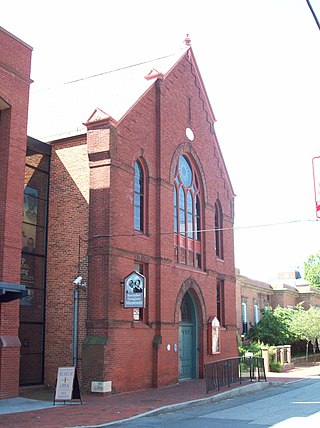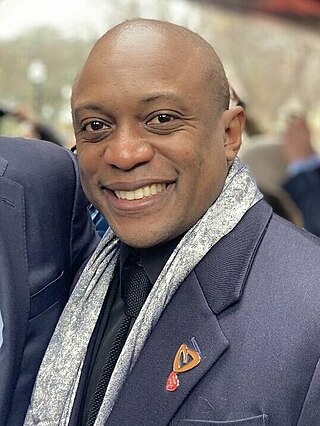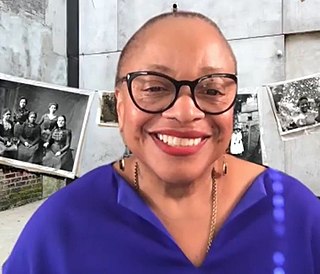Museum of African-American History may refer to:

Benjamin Banneker was an African-American naturalist, mathematician, astronomer and almanac author. A landowner, he also worked as a surveyor and farmer.

Charles Willson Peale was an American painter, soldier, scientist, inventor, politician, and naturalist.

Frances Ellen Watkins Harper was an American abolitionist, suffragist, poet, temperance activist, teacher, public speaker, and writer. Beginning in 1845, she was one of the first African American women to be published in the United States.
An African American is a citizen or resident of the United States who has origins in any of the black populations of Africa. African American-related topics include:

The African American Museum in Philadelphia (AAMP) is notable as the first museum funded and built by a municipality to help preserve, interpret and exhibit the heritage of African Americans. Opened during the 1976 Bicentennial celebrations, the AAMP is located in historic Philadelphia on Arch Street, a few blocks away from the Liberty Bell. It was formerly known as the Afro-American Historical and Cultural Museum.
African American Museum may refer to:
William C. Rhodes, III is a sculptural furniture designer who studied at the Baltimore School for the Arts. He then earned a BA in Furniture Building and Design from the University of the Arts in Philadelphia and a Master's of Fine Arts from the University of Massachusetts Dartmouth. Collections of various galleries and museums show Rhodes' work and they are featured in several major publications.
African-American neighborhoods or black neighborhoods are types of ethnic enclaves found in many cities in the United States. Generally, an African American neighborhood is one where the majority of the people who live there are African American. Some of the earliest African-American neighborhoods were in New Orleans, Mobile, Atlanta, and other cities throughout the American South, as well as in New York City. In 1830, there were 14,000 "Free negroes" living in New York City.

The Reginald F. Lewis Museum of Maryland African American History & Culture is a resource for information about the lives and history of African American Marylanders. The Lewis Museum's mission is to collect, preserve, interpret, document, and exhibit the contributions of African American Marylanders using its collection of over 11,000 documents and objects and resources drawn from across the country.

The Banneker-Douglass Museum, formerly known as Mt. Moriah African Methodist Episcopal Church, is a historic church at Annapolis, Anne Arundel County, Maryland. It was constructed in 1875 and remodeled in 1896. It is a 2+1⁄2-story, gable-front brick church executed in the Gothic Revival style. It served as the meeting hall for the First African Methodist Episcopal Church, originally formed in the 1790s, for nearly 100 years. It was leased to the Maryland Commission on African-American History and Culture, becoming the state's official museum for African-American history and culture. In 1984, a 2+1⁄2-story addition was added when the building opened as the Banneker-Douglass Museum.

Hank Willis Thomas is an American conceptual artist. Based in Brooklyn, New York, he works primarily with themes related to identity, history, and popular culture.

Smithsonian Libraries and Archives is an institutional archives and library system comprising 21 branch libraries serving the various Smithsonian Institution museums and research centers. The Libraries and Archives serve Smithsonian Institution staff as well as the scholarly community and general public with information and reference support. Its collections number nearly 3 million volumes including 50,000 rare books and manuscripts.
Philip Goodwin Freelon was an American architect. He was best known for leading the design team of the Smithsonian Institution's National Museum of African American History and Culture.

Deborah Willis is a contemporary African-American artist, photographer, curator of photography, photographic historian, author, and educator. Among her awards and honors, she is a 2000 MacArthur Fellow. She is currently Professor and Chair of the Department of Photography and Imaging at Tisch School of the Arts of New York University.

Sonya Clark is an American artist of Afro-Caribbean heritage. Clark is a fiber artist known for using a variety of materials including human hair and combs to address race, culture, class, and history. Her beaded headdress assemblages and braided wig series of the late 1990s, which received critical acclaim, evoked African traditions of personal adornment and moved these common forms into the realm of personal and political expression. Although African art and her Caribbean background are important influences, Clark also builds on practices of assemblage and accumulation used by artists such as Betye Saar and David Hammons.
Roland L. Freeman was an American photographer and award-winning documenter of Southern folk culture and African-American quilters. He was the president of The Group for Cultural Documentation based in Washington, D.C.
Martha Jackson Jarvis is an American artist known for her mixed-media installations that explore aspects of African, African American, and Native American spirituality, ecological concerns, and the role of women in preserving indigenous cultures. Her installations are composed using a variety of natural materials including terracotta, sand, copper, recycled stone, glass, wood and coal. Her sculptures and installations are often site-specific, designed to interact with their surroundings and create a sense of place. Her works often focus on the history and culture of African Americans in the southern United States. In her exhibition at the Corcoran, Jarvis featured over 100 big collard green leaves, numerous carp and a live Potomac catfish.
Joyce J. Scott is an African-American artist, sculptor, quilter, performance artist, installation artist, print-maker, lecturer and educator. Named a MacArthur Fellow in 2016, and a Smithsonian Visionary Artist in 2019, Scott is best known for her figurative sculptures and jewelry using free form, off-loom beadweaving techniques, similar to a peyote stitch. Each piece is often constructed using thousands of glass seed beads or pony beads, and sometimes other found objects or materials such as glass, quilting and leather. In 2018, she was hailed for working in new medium — a mixture of soil, clay, straw, and cement — for a sculpture meant to disintegrate and return to the earth. Scott is influenced by a variety of diverse cultures, including Native American and African traditions, Mexican, Czech, and Russian beadwork, illustration and comic books, and pop culture.
Joseph Holston is an American painter and printmaker best known for his portrayals of the African American experience, using vivid colors and expressive lines in a cubist-abstractionist style. His media include painting, etching, silk screen, and collage.

The history of African Americans in Baltimore dates back to the 17th century when the first African slaves were being brought to the Province of Maryland. Majority white for most of its history, Baltimore transitioned to having a black majority in the 1970s. As of the 2010 Census, African Americans are the majority population of Baltimore at 63% of the population. As a majority black city for the last several decades with the 5th largest population of African Americans of any city in the United States, African Americans have had an enormous impact on the culture, dialect, history, politics, and music of the city. Unlike many other Northern cities whose African-American populations first became well-established during the Great Migration, Baltimore has a deeply rooted African-American heritage, being home to the largest population of free black people half a century before the Emancipation Proclamation. The migrations of Southern and Appalachian African Americans between 1910 and 1970 brought thousands of African Americans to Baltimore, transforming the city into the second northernmost majority-black city in the United States after Detroit. The city's African-American community is centered in West Baltimore and East Baltimore. The distribution of African Americans on both the West and the East sides of Baltimore is sometimes called "The Black Butterfly", while the distribution of white Americans in Central and Southeast Baltimore is called "The White L."